ASRock Industrial NUC BOX-1260P and 4X4 BOX-5800U Review: Alder Lake-P and Cezanne UCFF Faceoff
by Ganesh T S on August 5, 2022 8:15 AM EST- Posted in
- Systems
- AMD
- Intel
- UCFF
- Mini-PC
- ASRock Industrial
- Cezanne
- Alder Lake-P
HTPC Credentials
The HTPC-related sections in previous SFF PC reviews covered a range of aspects. Display refresh rate stability (particularly, the ability to drive 23.976 Hz for stutter-free playback of cinema content), OTT streaming efficiency (YouTube and Netflix), and local media playback performance and efficiency evaluation were some of them. While such a detailed study may still make sense for dedicated HTPC reviews, we have decided to pare down the evaluated aspects for system reviews. Workloads were processed on the NUC BOX-1260P and the 4X4 BOX-5800U (Normal Mode) for the results in this section.
YouTube Streaming Efficiency
4K video streaming has become ubiquitous enough for its support to be a necessity even for secondary HTPCs. HDR has also become affordable. Both systems under consideration today can display HDR content in HDR. Keeping these aspects in mind, we have chosen Mystery Box's Peru 8K HDR 60FPS video as our test sample moving forward. On PCs running Windows, it is recommended that HDR streaming videos be viewed using the Microsoft Edge browser after putting the desktop in HDR mode.

YouTube Streaming Statistics
ASRock Industrial 4X4 BOX-5800U (L) and ASRock Industrial NUC BOX-1260P (R)
The integrated GPUs in both systems support hardware decoding for VP9 Profile 2. Taking advantage of this feature, MS Edge automatically fetches the 4Kp60 VP9 Profile 2 encode from the YouTube servers. However, the playback quality was markedly different - while the Alder Lake system played back the clip almost perfectly (the few dropped frames were during resolution changes / triggering of overlays), the Cezanne system had evident stuttering as a result of almost 10% of the frames getting dropped.
The decoding efficiency (GPU usage and at-wall power consumption against time) for the YouTube playback session is graphed below for both systems.
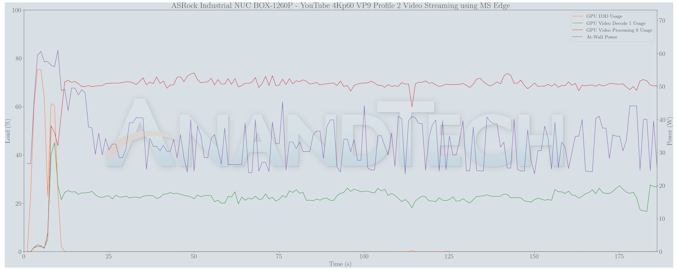
YouTube Streaming Decoding Efficiency - ASRock Industrial NUC BOX-1260P
 YouTube Streaming Decoding Efficiency - ASRock Industrial 4X4 BOX-5800U
YouTube Streaming Decoding Efficiency - ASRock Industrial 4X4 BOX-5800U
The reason for the dropped frames seems to be in the excessive D3D usage of the Cezanne GPU. The decoder load is also quite high at 80% and the at-wall numbers are close to 50W. In contrast, the NUC BOX-1260P consumes around 32W for the same playback while dropping barely any frames. The load on the decoder is around 25% with the video processor logic in the GPU kept active around 70%. Overall, the hardware acceleration offered by Alder Lake-P is very effective, while the Radeon iGPU struggles here despite claiming hardware decoding support for VP9 Profile 2.
Hardware-Accelerated Encoding and Decoding
The transcoding benchmarks in the systems performance section presented results from evaluating the QuickSync encoder within Handbrake's framework. The iGPU in the NUC BOX-1260P support hardware encode for AVC, JPEG, HEVC (8b and 10b, 4:2:0 and 4:4:4), and VP9 (8b and 10b, 4:2:0 and 4:4:4). The capabilities of the decoder engine are brought out by DXVAChecker.
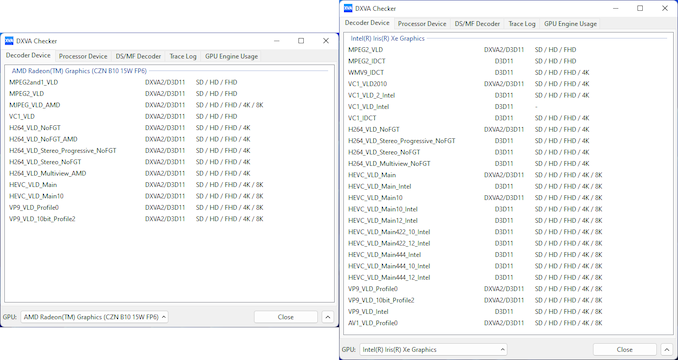
Video Decoding Hardware Acceleration
ASRock Industrial 4X4 BOX-5800U (L) and ASRock Industrial NUC BOX-1260P (R)
While MJPEG decode acceleration is available in Cezanne, Alder Lake-P does not offer it. In any case, most MJPEG streams are low-resolution and low-frame rate, which can be easily handled via software. The decoding capabilities of the Iris Xe Graphics are more comprehensive than Cezanne's.
Local Media Playback
Evaluation of local media playback and video processing is done by playing back files encompassing a range of relevant codecs, containers, resolutions, and frame rates. A note of the efficiency is also made by tracking GPU usage and power consumption of the system at the wall. Users have their own preference for the playback software / decoder / renderer, and our aim is to have numbers representative of commonly encountered scenarios. Considering the target market for UCFF systems like the ASRock Industrial NUC BOX and 4X4 BOX series, we played back the test streams using the following install-and-forget combinations:
- VLC 3.0.17.4
- Kodi 19.4
The fourteen test streams (each of 90s duration) were played back from the local disk with an interval of 30 seconds in-between. Various metrics including GPU usage and at-wall power consumption were recorded during the course of this playback.
All our playback tests were done with the desktop HDR setting turned on. It is possible for certain system configurations to automatically turn on/off the HDR capabilities prior to the playback of a HDR video, but, we didn't take advantage of that in our testing.
VLC and Kodi
VLC is the playback software of choice for the average PC user who doesn't need a ten-foot UI. Its install-and-play simplicity has made it extremely popular. Over the years, the software has gained the ability to take advantage of various hardware acceleration options. Kodi, on the other hand, has a ten-foot UI making it the perfect open-source software for dedicated HTPCs. Support for add-ons make it very extensible and capable of customization. We played back our test files using the default VLC and Kodi configurations, and recorded the following metrics.
| ASRock Industrial NUC BOX-1260P Video Playback Efficiency - VLC and Kodi | |||
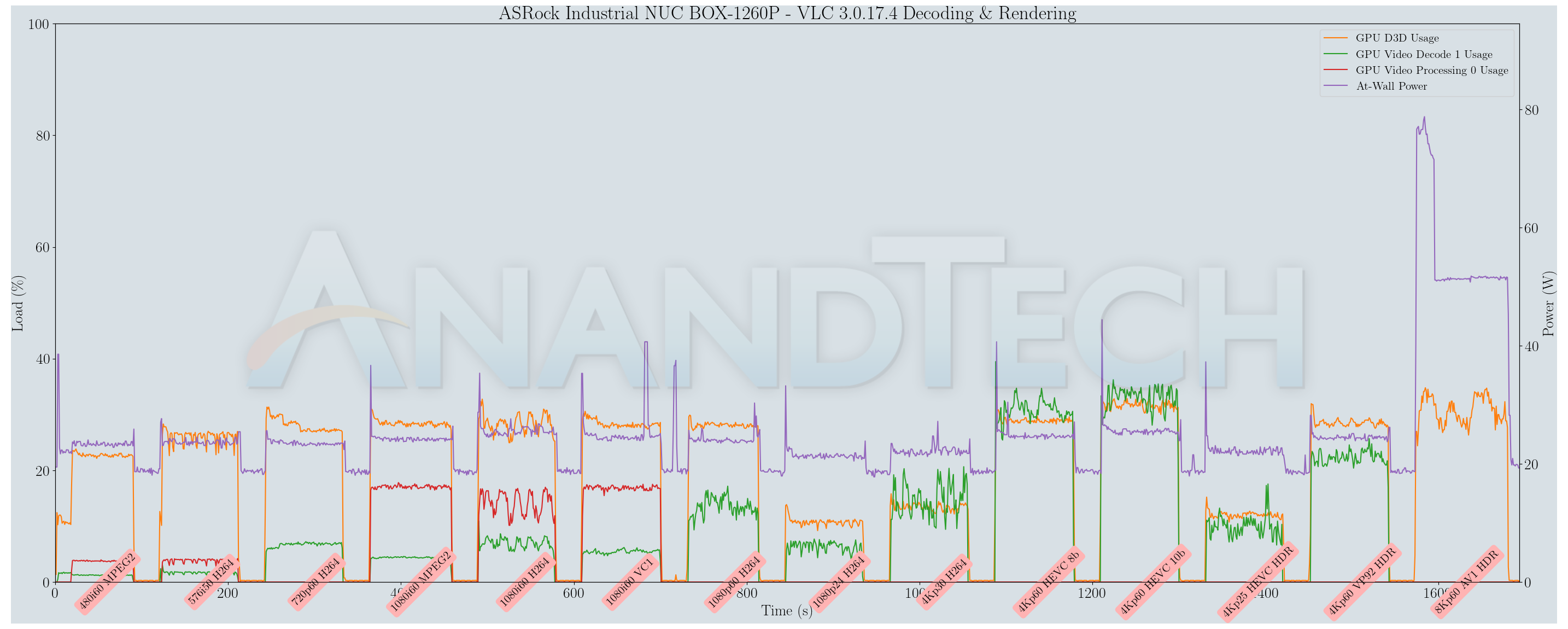
| ASRock Industrial 4X4 BOX-5800U Video Playback Efficiency - VLC and Kodi | |||
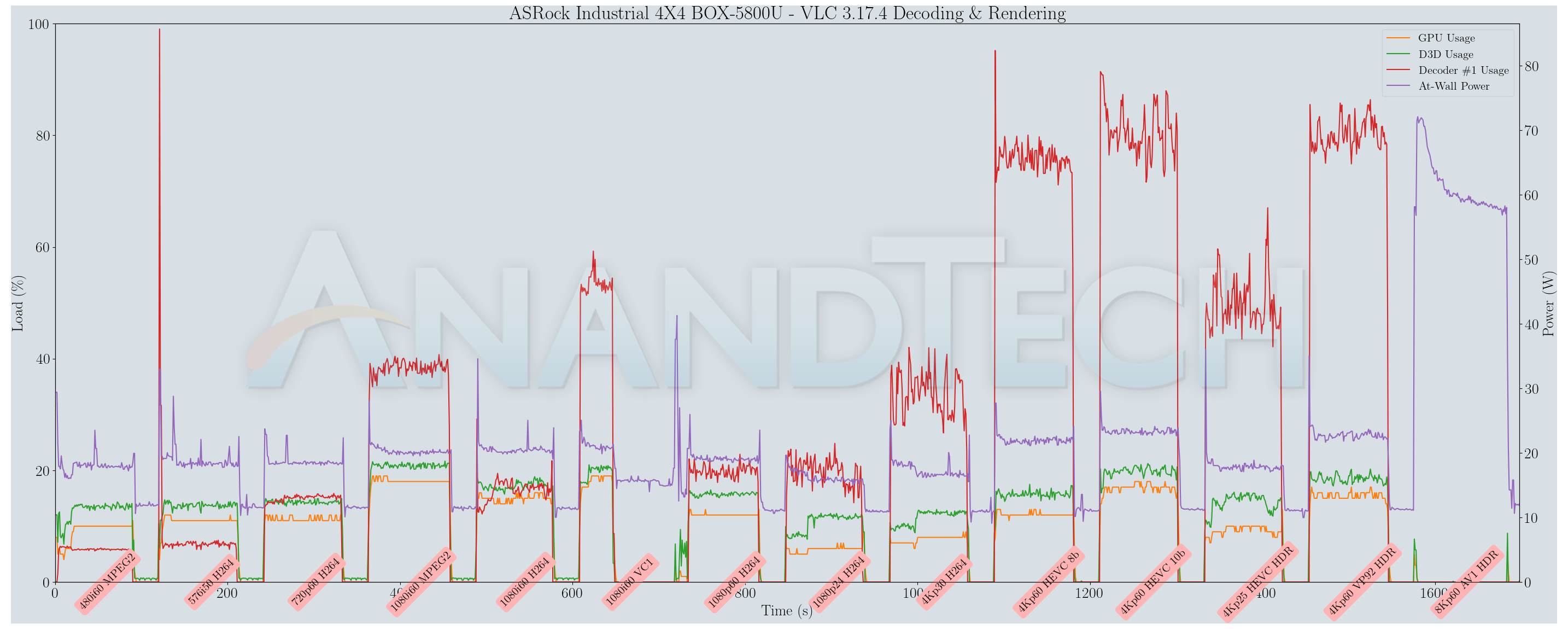
Both players in both systems had great trouble handling the 8Kp60 AV1 clip, due to the absence of hardware acceleration. In addition to consuming lots of power, the playback was just a sequence of frames updated every few seconds. Other than that, all other codecs played without missing a frame, with hardware acceleration activated for low-power playback in the NUC BOX-1260P. For the 4X4 BOX-5800U, some of the high frame-rate / high-resolution files encountered minor stuttering (seen when the decoder usage spiked upwards of 80% in the above graph) in VLC, but managed better playback in Kodi. The interlaced VC-1 clip presented some challenges, with the driver crashing mid-way through the playback in both VLC and Kodi. However, under certain Kodi configurations (in terms of full-sceren / windowed / window size), the playback would sometimes be successful. VLC would consistently crash.
While AMD needs to work on its drivers, the issue with the NUC BOX-1260P for AV1 decoding is one of software. Once Kodi and VLC get updates to take advantage of the hardware-accelerated AV1 decoding support in the newer Intel processors, the system should be able to play back the AV1 clip without issues.
Overall, the NUC BOX-1260P can be recommended for media playback of all varieties. The 4X4 BOX-5800U works well for most common codecs, but playback - either local or via network streaming - could sometimes be a hit or a miss depending on the codec, resolution, and browser.


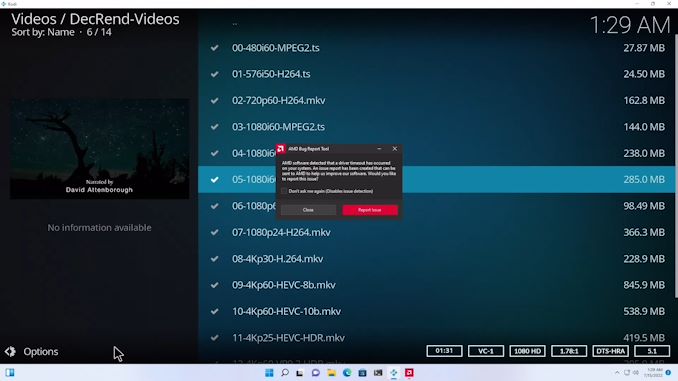








34 Comments
View All Comments
erotomania - Saturday, August 20, 2022 - link
Very nice writing, Ganesh. I enjoyed reading the whole article, and I perhaps most enjoyed the section on storage. I would read more, just sayin'.Oxford Guy - Sunday, August 21, 2022 - link
'Due to the variation in configured power limits for both processors, it is not possible to do a scientific apples-to-apples comparison for each benchmark.'And the differences between the SSDs.
Oxford Guy - Sunday, August 21, 2022 - link
Perhaps I missed it. Where is the decibel-to-performance data, or even a simple noise under tough real-world workload chart?stan_dman - Wednesday, August 24, 2022 - link
Impressive little pc's. I'd be interested how noisy the cooling is. I had an optiplex 7050 with i5-7500t (tdp 35w) gave me a headache with a whiny fan.